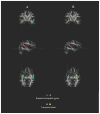Atypical diffusion tensor hemispheric asymmetry in autism
- PMID: 21182212
- PMCID: PMC3215255
- DOI: 10.1002/aur.162
Atypical diffusion tensor hemispheric asymmetry in autism
Abstract
Background: Biological measurements that distinguish individuals with autism from typically developing individuals and those with other developmental and neuropsychiatric disorders must demonstrate very high performance to have clinical value as potential imaging biomarkers. We hypothesized that further study of white matter microstructure (WMM) in the superior temporal gyrus (STG) and temporal stem (TS), two brain regions in the temporal lobe containing circuitry central to language, emotion, and social cognition, would identify a useful combination of classification features and further understand autism neuropathology.
Methods: WMM measurements from the STG and TS were examined from 30 high-functioning males satisfying full criteria for idiopathic autism aged 7-28 years and 30 matched controls and a replication sample of 12 males with idiopathic autism and 7 matched controls who participated in a previous case-control diffusion tensor imaging (DTI) study. Language functioning, adaptive functioning, and psychotropic medication usage were also examined.
Results: In the STG, we find reversed hemispheric asymmetry of two separable measures of directional diffusion coherence, tensor skewness, and fractional anisotropy. In autism, tensor skewness is greater on the right and fractional anisotropy is decreased on the left. We also find increased diffusion parallel to white matter fibers bilaterally. In the right not left TS, we find increased omnidirectional, parallel, and perpendicular diffusion. These six multivariate measurements possess very high ability to discriminate individuals with autism from individuals without autism with 94% sensitivity, 90% specificity, and 92% accuracy in our original and replication samples. We also report a near-significant association between the classifier and a quantitative trait index of autism and significant correlations between two classifier components and measures of language, IQ, and adaptive functioning in autism.
Copyright © 2010, International Society for Autism Research, Wiley Periodicals, Inc.
Figures



References
-
- Akshoomoff N, Lord C, Lincoln AJ, Courchesne RY, Carper RA, Townsend J, et al. Outcome classification of preschool children with autism spectrum disorders using MRI brain measures. J Am Acad Child Adolesc Psychiatry. 2004;43(3):349–357. - PubMed
-
- Alexander AL, Hasan K, Kindlmann G, Parker DL, Tsuruda JS. A geometric analysis of diffusion tensor measurements of the human brain. Magn Reson Med. 2000;44(2):283–291. - PubMed
-
- Alexander AL, Lee JE, Lazar M, Boudos R, DuBray MB, Oakes, et al. Diffusion tensor imaging of the corpus callosum in autism. Neuroimage. 2007;34(1):61–73. - PubMed
-
- Altham PME. Improving the precision of estimation by fitting a model. Journal of the Royal Statistical Society, Series B. 1984;46(1):118–119.
Publication types
MeSH terms
Grants and funding
- 2291/PHS HHS/United States
- F31DC010143/DC/NIDCD NIH HHS/United States
- P50 MH060450/MH/NIMH NIH HHS/United States
- 15879/PHS HHS/United States
- T32DC008553/DC/NIDCD NIH HHS/United States
- U19 HD035476/HD/NICHD NIH HHS/United States
- 35476/PHS HHS/United States
- 34783/PHS HHS/United States
- R01 MH084795/MH/NIMH NIH HHS/United States
- 60450/PHS HHS/United States
- P01 HD035476/HD/NICHD NIH HHS/United States
- R01 MH062015/MH/NIMH NIH HHS/United States
- F31 DC010143/DC/NIDCD NIH HHS/United States
- 084795/PHS HHS/United States
- T32 DC008553/DC/NIDCD NIH HHS/United States
- 080826/PHS HHS/United States
- R01 MH080826/MH/NIMH NIH HHS/United States
- R21 DA015879/DA/NIDA NIH HHS/United States
- R01 NS037483/NS/NINDS NIH HHS/United States
- 1677/PHS HHS/United States
- 62015/PHS HHS/United States
LinkOut - more resources
Full Text Sources
Other Literature Sources

